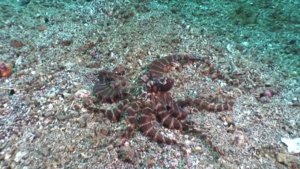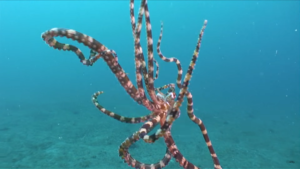In the vast, mysterious expanse of the oceans, where countless species remain hidden from our sight, the mimic octopus (*Thaumoctopus mimicus*) emerges as a remarkable and surprising cephalopod. Mimic octopuses, which thrive in the Indo-Pacific region, are celebrated for their extraordinary ability to mimic a diverse range of marine species with astonishing accuracy. Its unique adaptations, clever survival strategies and complex behavioral patterns continue to fascinate scientists and marine enthusiasts. In this exploration, we’ll highlight 12 fascinating facts that illuminate the captivating world of the mimic octopus.

1. Mysterious Origin:
The mimic octopus, although well known to marine biologists, retains a sense of mystery. Its mysterious abilities have puzzled researchers for generations, leading to its status as one of the ocean’s most mysterious inhabitants. This remarkable creature is found primarily in the Indo-Pacific, where its mimicry talent has evolved as a survival strategy of extraordinary proportions.
2. master of disguise:
One of the most attractive features of the mimic octopus is its unique talent for mimicry. It has the unique ability to mimic a wide variety of marine species with amazing precision. This includes mimicking lionfish, flatfish and even venomous sea snakes. This mimicry serves not only as a spectacle but also as an important survival strategy, enabling the octopus to avoid predators and effectively hunt prey.
3. Size and Appearance:
Typically, these captivating octopuses measure around 60 centimeters in length, making them relatively small compared to other cephalopods. Their physical characteristics include soft, flexible bodies with a grayish-brown base color. The dark bars or stripes on their arms provide a subtle but effective camouflage pattern, allowing them to blend seamlessly into their surroundings.
4. jet engine:
Similar to other octopus species, the mimic octopus uses a jet propulsion mechanism for locomotion. It expels water forcefully through a siphon, giving it the ability to move rapidly in any direction. This method of locomotion gives them agility and versatility when traveling in complex depths of the ocean.
5. solitary creature:
Unlike some social octopus species, mimic octopuses live primarily solitary lives. They favor an independent lifestyle, gathering with people of their own kind only for the purpose of mating. These octopuses establish territories and display territorial behavior, adding another layer of complexity to their existence.
6. Camouflage Expertise:
The mimic octopus is famous for its ability to not only change color but also adjust the texture of its skin to mimic other sea creatures. By changing the color and texture of its skin, it can blend seamlessly into its environment, rendering itself nearly invisible to potential threats. This camouflage expertise is an important component of its survival strategy.

7. varied diet:
Mimic octopuses are carnivorous, eating primarily small crustaceans and fish, including crabs and shrimp. With their powerful beaks, they can crack shells and immobilize prey using poisonous saliva. This versatile diet enhances their overall survival in the wild, enabling them to adapt to a variety of food sources.
8. complex nervous system:
These interesting cephalopods boast highly developed nervous systems. They display traits of intelligence, problem-solving skills, and the ability to learn. This adaptability empowers them to respond effectively to changing circumstances and adopt the most appropriate coping strategies, which is a testament to their extraordinary abilities.
9. hunter theft:
When faced with danger, the mimic octopus relies on its mimicry skills to avoid potential predators. It can rapidly change its appearance to mimic a more dangerous creature such as a lion fish. This sudden change often confuses or deters potential attackers, as they mistake the octopus for a poisonous or dangerous species.
10. Mating and reproduction:
During the breeding season, mimic octopuses come together for the purpose of breeding. The male uses a specialized arm called a hectocotyle to transfer sperm packets to the female. After mating, females lay clutches of eggs, which they diligently guard and protect until they hatch. This entire reproductive process is essential for the continuation of the species.
11. Housing and Delivery:
Mimic octopuses are typically found in sandy and silty sea bottoms, often inhabiting estuaries and shallow coastal waters. Their distribution extends from the east coast of Africa to the western Pacific Ocean, including areas such as Indonesia, the Philippines, and Australia. Their adaptability to different habitats underlines their ecological importance.
12. Ongoing scientific interest:
The mimic octopus remains a subject of great interest to the scientific community. Researchers are eager to delve deeper into its genetics, the mechanisms underlying its mimicry, and the implications of its intelligent behavior. This ongoing study of the mimic octopus is a reminder of the deep mysteries the ocean still hides and the importance of conserving these extraordinary creatures.
conclusion
In the mesmerizing depths of the Indo-Pacific, the mimic octopus, with its extraordinary mimicry skills, complex behavior and unique adaptations, stands as testament to the wonders of the natural world. As we continue to explore vast ocean areas, we uncover not only the hidden treasures of the ocean but also the miracles of adaptation and evolution that have allowed the mimic octopus to survive in its complex underwater habitat. Enable them to flourish in. Each revelation emphasizes the inexhaustible mysteries of marine life, inspiring us to unravel the mysteries of the depths. The mimic octopus, adept at disguise and survival, inspires us to celebrate the diverse and awe-inspiring creatures that inhabit our oceans, highlighting the need for their conservation and expanding our understanding of the oceans they inhabit Call it our home.
